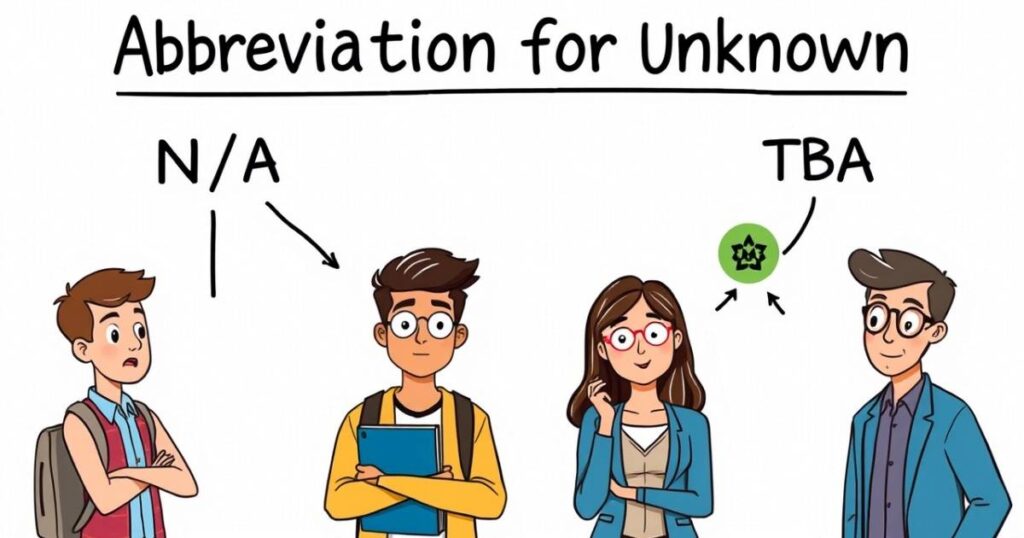The abbreviation for unknown is a secret weapon in communication, popping up across various fields to save time and space. Whether you’re reading medical records, scientific research, or legal documents, you’ll often spot UNK standing in for the unknown. It’s a simple yet powerful shorthand that makes complex information easier to digest.
In legal contexts, the abbreviation for unknown can clear up ambiguity when a defendant’s prior convictions are unclear. In research, it helps explain when the cause of a phenomenon is unknown or when there’s missing data. The abbreviation for unknown cuts down on long-winded explanations, making writing more efficient. Whether in technical writing or everyday use, this abbreviation is a real game-changer!
What is the Abbreviation for Unknown?
In different fields, like science, law, or medical records, there are times when a value, name, or detail isn’t known. Instead of leaving a blank space, people often use a short form or abbreviation to show that something is missing or unidentified. This helps avoid confusion and keeps records consistent and tidy.
Abbreviations can vary depending on the setting. For instance, one system might use one shorthand in a police report, while another might use something else in a research lab. Despite the variety, they all point to the same idea: the detail just isn’t available yet.
These shortcuts are practical. They save time, keep information standardized, and help professionals communicate quickly. Imagine sorting through hundreds of files, having a clear, consistent mark for missing info makes everything simpler.
It’s also useful when inputting data into software or databases that require every field to have something in it. Instead of typing long phrases every time something’s missing, a short code gets the job done faster.
Common Examples in Context:
- A coroner’s report might list the cause of death as “UNK.”
- On a medical form, a patient’s blood type might be recorded as “U/K.”
- Police records might use “X” to represent an unidentified person.
- In scientific data, “NA” (not available) is sometimes used.
- Shipping labels might show “TBD” (to be determined) for an unknown delivery date.
Sometimes, the abbreviation depends on tradition or policy within an organization. Other times, it’s based on what’s easiest to recognize.
Ultimately, these codes act like placeholders, giving you a heads-up that the information’s missing, at least for now.
What Does Abbreviation for Unknown Mean?

Sometimes in documents, not every piece of information is available. Maybe someone’s name isn’t known, or a detail hasn’t been confirmed yet. That’s where a quick abbreviation comes in handy.
Using an abbreviation saves time. Instead of writing out a full sentence to explain what’s missing, a few letters do the job. It’s simple, fast, and easy to recognize.
Different fields have their own common shorthand. In healthcare, you might see one set of letters, while in law enforcement or research, a different version might be used. The purpose is the same, it stands in for what’s not yet known.
These little codes are helpful in data entry, too. Many systems won’t accept empty fields, so having an agreed-upon abbreviation avoids technical errors.
They’re also used in spoken communication. A doctor or officer might say the abbreviation aloud to quickly explain a gap in the information.
Overall, this kind of abbreviation is a small but powerful tool. It keeps communication clear, avoids confusion, and lets everyone know that something is temporarily unknown, not forgotten.
Definition, Pronunciation, and Examples
An abbreviation for unknown is a short form or code used to indicate that specific information is missing, unavailable, or not yet identified. It’s a placeholder that shows the detail is currently not known.
Pronunciation
The word unknown is pronounced: /ʌnˈnoʊn/
Break it down like this: un-NONE
It has two syllables and the stress is on the second part: known.
Examples in Use
- The patient’s allergy history: UNK
- Suspect’s identity in a report: U/K
- DNA test result still pending: TBD
- Nationality not confirmed: NA
- Time of event not yet decided: TBC
Each of these gives a quick way to show that a detail isn’t available, without leaving things blank or unclear.
The Pronunciation of “Unknown”
It has two syllables: un (like “fun”) and known (rhymes with “tone”).
The stress is on the second syllable: un-KNOWN
Here’s a simple way to say it:
Un-NONE, with a clear pause before the second part.
It’s a common word in both casual speech and formal settings, especially when something can’t be identified or hasn’t been discovered yet.
Short Abbreviation for Unknown
The most widely used and simple abbreviation for “unknown” is UNK. It’s a handy shorthand that shows something is either not identified or unavailable. This abbreviation is commonly used across various sectors, including healthcare, law enforcement, and research, to maintain consistency when information is missing or uncertain.
In a medical setting, for example, if a patient’s allergy status is not available, it may be recorded as UNK. This provides a clear, standardized way to represent missing data without leaving fields blank.
Example: “The patient’s previous surgeries: UNK.”
What makes UNK so popular is its efficiency. It’s quick to write and easy to understand, making it ideal for use in reports, forms, and databases where speed and clarity are key. It ensures that the absence of information is clearly noted, preventing confusion without adding unnecessary complexity.
In addition, UNK is recognized across different industries, from legal paperwork to scientific studies. This universal understanding helps create a seamless flow of information and ensures that everyone, regardless of their field, knows exactly what’s meant when they encounter the abbreviation.
Acronym for Unknown?
This abbreviation is commonly used in various fields to indicate that certain information is missing or unidentified. It’s particularly useful in medical, legal, and research documentation, where space is often limited, and quick notation is needed.
For instance, if a report lacks a specific detail, such as a suspect’s identity, it might be marked as UNK to indicate that the information is currently unavailable.
Example: “The suspect’s identity is listed as UNK.”
The advantage of using UNK is its simplicity and wide recognition. It saves time and avoids the need for lengthy explanations while making it clear that the missing information is just unknown, not forgotten.
Related Guide:
Abbreviation for Magnesium: Chemical Symbol Mg – Verbo Master
“UNK” vs. “N/A”: When to Use Each
While both UNK and N/A are shorthand for missing or unavailable information, they are used in different contexts to convey distinct meanings. Understanding when to use each can improve clarity in documentation.
UNK (Unknown) is used when the information is not yet available, identified, or discovered. It implies that the data exists but is currently unknown or pending. For example, in medical or legal records, when a person’s medical history or identity hasn’t been confirmed, UNK would be used to show that the detail is still unknown.
Example: “Patient’s blood type: UNK.”
N/A (Not Applicable), however, is used when the information requested doesn’t apply to the situation at hand. It indicates that the question or category is irrelevant to the person or context. For instance, if someone doesn’t have a middle name, a form asking for one would be filled in with N/A, as the question doesn’t apply.
Example: “Middle name: N/A.”
Both abbreviations help streamline documentation, but it’s essential to use them correctly. UNK is for cases where the information is simply missing or unavailable, while N/A applies when a field or question is not relevant at all. Using them appropriately ensures accurate communication, particularly in formal documents, databases, and reports where precision matters.
Other Examples of Unknown in Context
- Medical Record
When a patient’s allergy history is missing or not provided, it may be recorded as UNK. This indicates that the healthcare provider hasn’t yet identified the patient’s allergies.
Example: “Allergy information: UNK.” - Police Report
If the identity of a suspect is unknown during an investigation, officers might list it as UNK until further details are discovered.
Example: “Suspect’s identity: UNK.” - Research Data
In scientific studies, UNK is used to denote missing data that has not yet been collected or processed, such as the results of an experiment still pending.
Example: “Test results: UNK.” - Employee Records
In employment documentation, UNK can be used when information like a previous employer or certain work experience is missing or has not been disclosed yet.
Example: “Previous employment: UNK.” - Survey Forms
When filling out surveys, if a participant’s age or gender is not disclosed, it might be marked as UNK to indicate the data is unavailable.
Example: “Age: UNK.”
These examples show how UNK is a useful shorthand for indicating that specific details are either not available or haven’t been discovered yet, keeping documentation clear and consistent.
Synonyms and Antonyms for Unknown

Let’s explore some alternatives to the word “unknown.” There are several synonyms that convey the idea of something not being identified or lacking clarity.
- Unidentified: This term is often used when something, like a person or object, is not yet recognized or has no clear name attached.
Example: “The victim was found in an unidentified location.” - Uncertain: Used when the situation or information is unclear or not confirmed.
Example: “The cause of the problem remains uncertain.” - Obscure: Refers to something that is not well-known or is hard to understand.
Example: “The obscure details of the case were never fully revealed.” - Hidden: This is used when something is concealed or not visible, suggesting it’s being kept from view.
Example: “The hidden treasure remains untouched.”
On the other hand, the antonyms of “unknown” are words like known, identified, or recognized, which indicate familiarity or certainty. These terms imply that the information is clear or has been established.
- Known: The opposite of unknown, something familiar or understood.
Example: “The facts were known to everyone in the room.” - Identified: To be recognized or named.
Example: “The suspect was identified by witnesses.”
By using these synonyms and antonyms, you can more precisely convey the state of knowledge or mystery surrounding a situation.
The History of the Word Abbreviation for Unknown
The use of abbreviations to represent “unknown” dates back to a time when language needed to be simplified for efficiency, especially in written records and documents. Abbreviations are crucial in saving space and making communication faster, especially when dealing with repetitive or complex terms. The abbreviation UNK, for example, has become widely accepted and is used in various professional and technical fields to represent “unknown.”
Historically, the concept of abbreviating “unknown” can be traced back to ancient systems of writing, where shorthand was used to save time in recording transactions or information. For instance, in ancient Greece and Rome, scribes often used abbreviated forms of words in public records to make the process of documentation faster and more efficient.
In more recent history, during the 20th century, as databases, medical records, and legal documents became more formalized, the abbreviation UNK gained popularity. It was used in fields like healthcare, law enforcement, and research, where space was limited and quick identification of missing information was essential. The UNK abbreviation allowed for the simple notation of missing or unidentified data without cluttering documents with long explanations.
As digital documentation grew, UNK became a standard in computerized systems. It is now widely recognized across industries, from healthcare to data management, and has become a staple in modern communication when referring to unknown or missing information.
Today, UNK is not just a historical shorthand but a modern tool that streamlines the recording and communication of missing details in professional environments.
When to Use the Abbreviation for Unknown

When should you use UNK? The abbreviation is most commonly used in professional, technical, or formal contexts to indicate missing, unavailable, or unconfirmed information.
You’ll typically find UNK in environments like medical records, research reports, and official documentation, where it’s important to note that certain details have not yet been identified or are still pending.
For instance, in a police report, an officer might write:
“Suspect’s identity: UNK.”
This indicates that the identity of the suspect is unknown at the time the report is being filed, but could be determined later.
However, in informal writing or day-to-day communication, it’s usually best to avoid abbreviations like UNK. Instead, you should spell out “unknown” to maintain a more approachable and clear tone, especially in conversations or non-technical contexts. Using UNK in casual situations can come across as too clinical or technical.
Examples of the Word and Abbreviations in Context
- Medical Records
In a medical setting, UNK is often used when a patient’s information is not available or unknown. It’s a quick way to denote missing or undetermined details.
Example:
“Patient’s blood type: UNK.”
This shows that the healthcare provider hasn’t yet determined the patient’s blood type. - Police Reports
Law enforcement officers use UNK when certain details, such as the identity of a suspect, are not yet known.
Example:
“Suspect’s identity: UNK.”
This indicates that the suspect’s identity is still unidentified at the time of the report. - Surveys and Forms
In surveys, forms, or questionnaires, UNK is used when a respondent’s answer is missing or unavailable. It’s a straightforward way to highlight incomplete information.
Example:
“Previous employer: UNK.”
This marks that the respondent did not provide information about their previous employer. - Research and Data
In research or data collection, UNK is used to represent data points that are missing, unavailable, or have yet to be discovered.
Example:
“Test result: UNK.”
This shows that the results of the test have not yet been obtained or documented. - Legal Documents
Legal professionals might use UNK to indicate that certain details, such as the location of evidence or an individual’s status, are not yet available.
Example:
“Defendant’s alibi: UNK.”
This indicates that the defendant’s alibi has not been confirmed or disclosed at the time.
These examples demonstrate how UNK is used across various professional fields to mark missing or unidentified information, keeping records clear and concise.
FAQ’s
What is the abbreviation for “unknown”?
The abbreviation for unknown is typically “UNK.” It is used in various fields like medical records, legal documents, and research to represent missing or unclear information.
Does UNK mean unknown?
Yes, “UNK” is a common abbreviation for unknown. It is used in medical, legal, and scientific contexts to signify something that is not identified or unclear.
What does NA stand for in abbreviation?
“NA” stands for “Not Applicable” or “Not Available,” depending on the context. It is different from the abbreviation for unknown, which is “UNK.”
What is the medical abbreviation for unknown?
In the medical field, the abbreviation for unknown is often “UNK.” It is used in patient charts or medical records to indicate missing or unclear information.
What is URD in medical terms?
In medical terms, “URD” stands for “Unresolved Disease.” While not an abbreviation for unknown, it refers to conditions that remain unidentified or unclear in diagnosis.
Final Thoughts
The abbreviation for unknown is a handy tool in many areas. It helps save space and makes writing clearer. Whether it’s in medical charts, legal documents, or scientific studies, the abbreviation for unknown is used to represent missing or unclear information. It’s an efficient way to convey uncertainty without extra words.
The abbreviation for unknown also plays a key role in research and data analysis. When scientists face unanswered questions or an unidentified cause, they use the abbreviation for unknown to keep things simple. In legal writing, it can help when a defendant’s prior convictions are unclear. The abbreviation for unknown is a small but powerful way to handle missing data or ambiguous details in technical writing. It’s a must-have tool for quick, effective communication.

Atlas Reid is an experienced administrator with 5 years of expertise in managing operations, streamlining processes, and ensuring efficiency. Skilled in leadership, organization, and problem-solving to drive business success.








